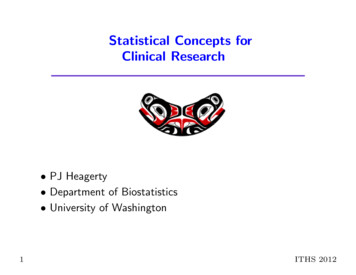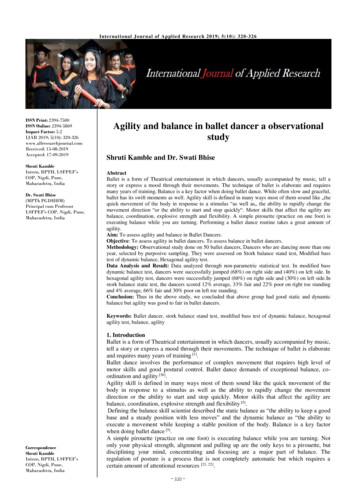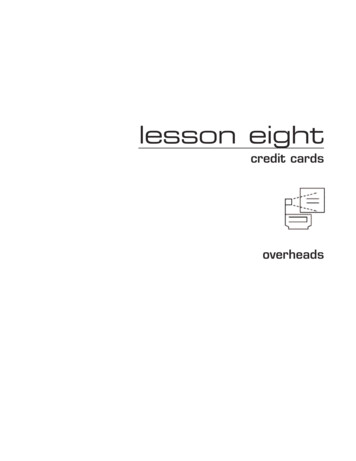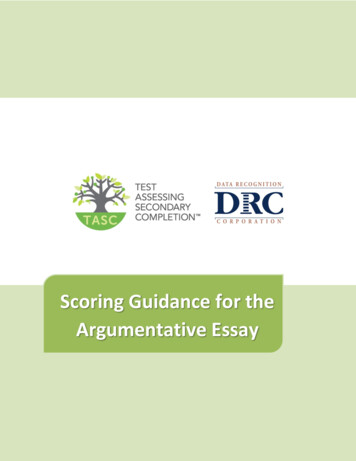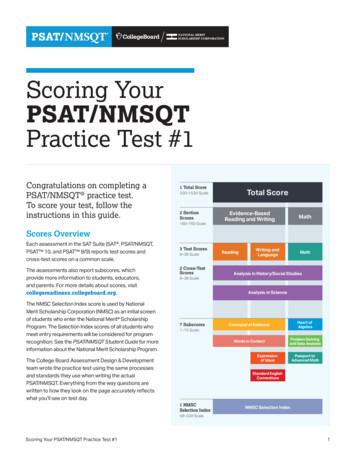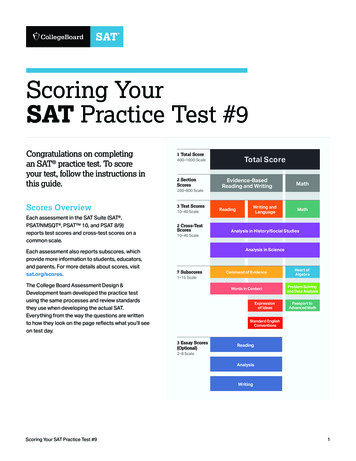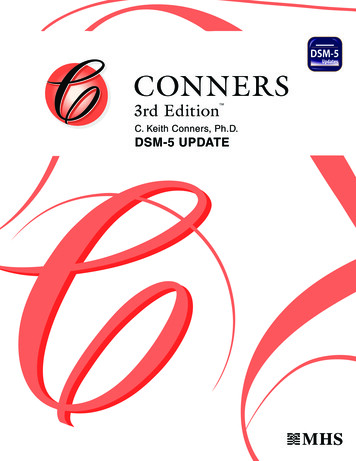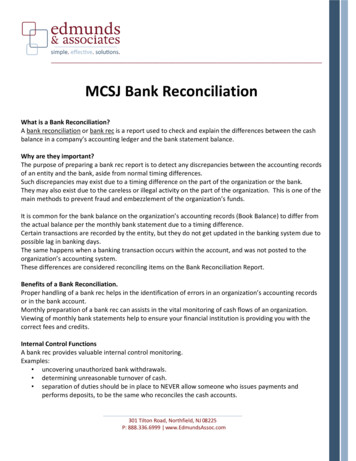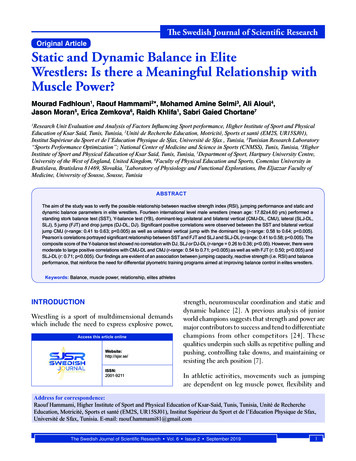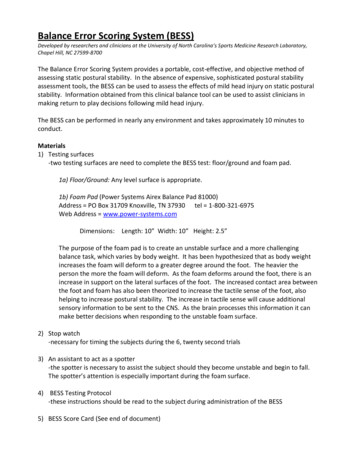
Transcription
Balance Error Scoring System (BESS)Developed by researchers and clinicians at the University of North Carolina’s Sports Medicine Research Laboratory,Chapel Hill, NC 27599-8700The Balance Error Scoring System provides a portable, cost-effective, and objective method ofassessing static postural stability. In the absence of expensive, sophisticated postural stabilityassessment tools, the BESS can be used to assess the effects of mild head injury on static posturalstability. Information obtained from this clinical balance tool can be used to assist clinicians inmaking return to play decisions following mild head injury.The BESS can be performed in nearly any environment and takes approximately 10 minutes toconduct.Materials1) Testing surfaces-two testing surfaces are need to complete the BESS test: floor/ground and foam pad.1a) Floor/Ground: Any level surface is appropriate.1b) Foam Pad (Power Systems Airex Balance Pad 81000)Address PO Box 31709 Knoxville, TN 37930 tel 1-800-321-6975Web Address www.power-systems.comDimensions: Length: 10” Width: 10” Height: 2.5”The purpose of the foam pad is to create an unstable surface and a more challengingbalance task, which varies by body weight. It has been hypothesized that as body weightincreases the foam will deform to a greater degree around the foot. The heavier theperson the more the foam will deform. As the foam deforms around the foot, there is anincrease in support on the lateral surfaces of the foot. The increased contact area betweenthe foot and foam has also been theorized to increase the tactile sense of the foot, alsohelping to increase postural stability. The increase in tactile sense will cause additionalsensory information to be sent to the CNS. As the brain processes this information it canmake better decisions when responding to the unstable foam surface.2) Stop watch-necessary for timing the subjects during the 6, twenty second trials3) An assistant to act as a spotter-the spotter is necessary to assist the subject should they become unstable and begin to fall.The spotter’s attention is especially important during the foam surface.4) BESS Testing Protocol-these instructions should be read to the subject during administration of the BESS5) BESS Score Card (See end of document)
BESS Test Administration1) Before administering the BESS, the following materials should be present:-foam pad-stop watch-spotter-BESS Testing Protocol-BESS Score Card2) Before testing, instruct the individual to remove shoes and any ankle taping if necessary.Socks may be worn if desired.3) Read the instructions to the subject as they are written in the BESS Testing Protocol.4) Record errors on the BESS Score Card as they are described below.Scoring the BESSEach of the twenty-second trials is scored by counting the errors, or deviations from the properstance, accumulated by the subject. The examiner will begin counting errors only after theindividual has assumed the proper testing position.Errors: An error is credited to the subject when any of the following occur: moving the hands off of the iliac crests opening the eyes step stumble or fall abduction or flexion of the hip beyond 30 lifting the forefoot or heel off of the testing surface remaining out of the proper testing position for greater than 5 seconds-The maximum total number of errors for any single condition is 10.Normal Scores for Each Possible Testing SurfaceFirm SurfaceFoam SurfaceDouble Leg Stance.009 .12.33 .90Single Leg Stance2.45 2.335.06 2.80Tandem Stance.91 1.363.26 2.62Surface Total3.37 3.108.65 5.13BESS Total Score12.03 7.34Maximum Number of Errors Possible for Each Testing SurfaceFirm SurfaceFoam SurfaceDouble Leg Stance1010Single Leg Stance1010Tandem Stance1010Surface Total3030-if a subject commits multiple errors simultaneously, only one error is recorded. For example, if anindividual steps or stumbles, opens their eyes, and removes their hands from their hipssimultaneously, then they are credited with only one error.
-subjects that are unable to maintain the testing procedure for a minimum of five seconds areassigned the highest possible score, ten, for that testing condition.A&D: Double leg stance: Standing on a firm surface with feet side by side (touching), hands on thehips and eyes closedB&E: Single leg stance: Standing on a firm surface on the non-dominant foot (defined below), thehip is flexed to approximately 30 and knee flexed to approximately 45 . Hands are on the hipsand eyes closed.*Non-Dominant Leg: The non-dominant leg is defined as the opposite leg of the preferredkicking legC&F: Tandem Stance: Standing heel to toe on a firm surface with the non-dominate foot (definedabove) in the back. Heel of the dominant foot should be touching the toe of the non-dominantfoot. Hands are on the hips and their eyes are closed.
Script for the BESS Testing ProtocolDirection to the subject: I am now going to test your balance.Please take your shoes off, roll up your pant legs above ankle (if applicable), and removeany ankle taping (if applicable).This test will consist of 6 - twenty second tests with three different stances on two differentsurfaces. I will describe the stances as we go along.DOUBLE LEG STANCE:Direction to the subject: The first stance is standing with your feet together like this[administrator demonstrates two-legged stance]You will be standing with your hands on your hips with your eyes closed. You should try tomaintain stability in that position for entire 20 seconds. I will be counting the number oftimes you move out of this position. For example: if you take your hands off your hips,open your eyes, take a step, lift your toes or your heels. If you do move out of the testingstance, simply open your eyes, regain your balance, get back into the testing position asquickly as possible, and close your eyes again.There will be a person positioned by you to help you get into the testing stance and to helpif you lose your balance.Direction to the spotter: You are to assist the subject if they fall during the test and tohelp them get back into the position.Direction to the subject: Put your feet together, put your hands on your hips and whenyou close your eyes the testing time will begin [Start timer when subject closes their eyes]SINGLE LEG STANCE:Direction to subject: If you were to kick a ball, which foot would you use? [This will bethe dominant foot]Now stand on your non-dominant foot.[Before continuing the test assess the position of the dominant leg as such: the dominantleg should be held in approximately 30 degrees of hip flexion and 45 degrees of kneeflexion]Again, you should try to maintain stability for 20 seconds with your eyes closed. I will becounting the number of times you move out of this position.Place your hands on your hips. When you close your eyes the testing time will begin.[Start timer when subject closes their eyes]
Direction to the spotter: You are to assist the subject if they fall during the test and tohelp them get back into the position.TANDEM STANCE:Directions to the subject: Now stand heel-to-toe with your non-dominant foot in back.Your weight should be evenly distributed across both feet.Again, you should try to maintain stability for 20 seconds with your eyes closed. I will becounting the number of times you move out of this position.Place your hands on your hips. When you close your eyes the testing time will begin.[Start timer when subject closes their eyes]Direction to the spotter: You are to assist the subject if they fall during the test and tohelp them get back into the position.*** Repeat each set of instructions for the foam padScore CardBalance Error Scoring System (BESS)(Guskiewicz)Balance Error Scoring System –Types of Errors1. Hands lifted off iliac crest2. Opening eyes3. Step, stumble, or fall4. Moving hip into 30 degrees abduction5. Lifting forefoot or heel6. Remaining out of test position 5 secThe BESS is calculated by adding oneerror point for each error during the 620-second tests.Which foot was tested: Left Right(i.e. which is the non-dominant foot)SCORE CARD:(# errors)Double Leg Stance(feet together)Single Leg Stance(non-dominant foot)Tandem Stance(non-dom foot in back)Total Scores:BESS TOTAL:FIRMSurfaceFOAMSurface
assessing static postural stability. In the absence of expensive, sophisticated postural stability assessment tools, the BESS can be used to assess the effects of mild head injury on static postural stabilit

